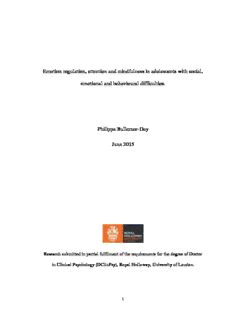
Emotion regulation, attention and mindfulness in adolescents with social, emotional and ... PDF
Preview Emotion regulation, attention and mindfulness in adolescents with social, emotional and ...
Emotion regulation, attention and mindfulness in adolescents with social, emotional and behavioural difficulties. Philippa Bullemor-Day June 2015 Research submitted in partial fulfilment of the requirements for the degree of Doctor in Clinical Psychology (DClinPsy), Royal Holloway, University of London. 1 Acknowledgments I would like to say a massive thank you to both my supervisors, Catherine Sebastian and Tamsin Owen, for their invaluable support and guidance throughout this whole process. I would also like to thank my research assistant, Tyler Saunders, for all his help collecting the data, and cutting the time it would have taken me in half, and John Rogers at Delosis for the time and effort he put into creating the computerised battery, and his support and patience with me trying to use it! Also, to all the schools, teachers and students that took part, I am extremely grateful for your time and perseverance with the study tasks. Finally, I would like to thank the family and friends that have listened to me moan for the last few months but continued to encourage and support me as always. 2 Abstract Social, emotional, and behavioural difficulties (SEBD) impact significantly on the life, education, and psychological wellbeing of adolescents. A central factor in the development and maintenance of SEBD is emotion regulation (the ability to regulate emotional responses). Emotion regulation has been linked to attention and mindfulness, where studies have showed positive correlations between these constructs. Mindfulness-based interventions are beginning to be widely used, however have been studied very little in adolescents with SEBD, despite this population being recognised as having distinct difficulties with emotion regulation and attention, and a group in need of helpful interventions. Furthermore, there is little research exploring the mechanisms underlying mindfulness, particularly in adolescents. The present study aimed to investigate the relationships between emotion regulation, attention and mindfulness in adolescents with SEBD and controls. In particular, the study explored the mediating role of attention in the relationship between mindfulness and emotion regulation, and looked specifically at the effect of varying levels of callous- unemotional traits on these relationships. Adolescents aged 11-16 with identified SEBD and controls participated in the study which used self-reported and teacher- rated questionnaires as well as cognitive tasks to measure levels of SEBD, emotion regulation, attention and trait mindfulness. The results showed there were significant positive correlations between emotion regulation, attention and mindfulness in adolescents with SEBD and in controls, when using particular measures of these variables. Attention was found to significantly mediate the relationship between mindfulness and emotion regulation. The results, however, showed little support for any differences between the relationships between these constructs in those with 3 varying levels of callous-unemotional traits. The results are helpful in adding to theories surrounding emotion regulation, attention and mindfulness in adolescents, particularly in adolescents with SEBD, where research is more limited, and have important implications for developing and tailoring interventions in both clinical and educational settings. 4 List of Tables Table 1: Breakdown of participant demographics by group…...................................81 Table 2: Means, SDs and ranges for self-reported questionnaire scores….…………82 Table 3: Means, SDs and ranges for teacher-rated questionnaire scores……………87 Table 4: Means, SDs and ranges for the emotional n-back task......…………………90 Table 5: Means, SDs and ranges for the flanker task………..………………………93 Table 6: Correlations between emotion regulation, attention and mindfulness variables………………………………………………………………………………98 Table 7: Correlations between emotion regulation, attention and mindfulness variables for those with high and low levels of callous-unemotional traits…………………………………………………………………………………107 5 List of Figures Figure 1: Process model of emotion regulation reproduced from Gross and Thompson (2007, p. 10)………………………………………………………………………….20 Figure 2: The components of attention based on Posner & Petersen (1990)………………………………………………………………………………...33 Figure 3: Attention as a mediator in the relationship between mindfulness and emotion regulation…..………………………………………………………………..56 Figure 4: Emotional n-back stimuli showing the fixation cross and numbers flanked by emotional faces………………...…………………………………………….........66 Figure 5a: Flanker task trial sequence for congruent cue and congruent target condition.…..................................................................................................................68 Figure 5b: Flanker task trial sequence for incongruent cue and congruent target condition.…..................................................................................................................68 Figure 5c: Flanker task trial sequence for congruent cue and incongruent target condition.…..................................................................................................................69 Figure 5d: Flanker task trial sequence for incongruent cue and incongruent target condition.…..................................................................................................................69 Figure 6: Mean accuracy scores on the two n-back conditions for SEBD and control groups………………………………………………………………………………...90 Figure 7a: Flanker task mean accuracy scores for each condition across groups…..…………………………………………………………………………….95 6 Figure 7b: Flanker task mean reaction times for each condition across groups…..…………………………………………………………………………….95 Figure 8: Mediating effect of attention on the relationship between mindfulness and emotion……………………………………………………………………………...105 7 Table of Contents Title Page………………………………………………………………………………1 Acknowledgements……………………………………………………………………2 Abstract………………………………………………………………………………..3 List of Tables…………………………………………………………………………..5 List of Figures………………………………………………………………………....6 Chapter 1: Introduction…………….…………………………………………………………...14 1.1 Overview…………………………………………………………………14 1.2 Social, emotional, and behavioural difficulties…………………………..16 Conduct problems and callous-unemotional traits in SEBD…………17 1.3 Emotion regulation……………………………………………………….18 Definition……………………………………………………………..18 Emotion regulation strategies………………………………………...19 Development of emotion regulation strategies……………………….21 Emotion regulation and mental health………………………………..21 Emotion regulation and SEBD……………………………………….23 Emotion regulation and conduct problems…………………………...26 Measuring emotion regulation………………………………………..28 8 1.4 Attention………………………………………………………………….32 Definition……………………………………………………………..32 Attention and emotion regulation…………………………………….33 Attention as an emotion regulation strategy………………….33 Training attention to improve emotion regulation…………...35 1.5 Mindfulness………………………………………………………………38 Definition……………………………………………………………..38 State versus trait mindfulness………………………………………...38 Measuring mindfulness………………………………………………40 Mindfulness-based interventions……………………………………..42 Research in adults…………………………………………….43 Research in adolescents………………………………………44 Theories of mindfulness……………………………………………...50 Mechanisms underlying mindfulness………………………………...51 Attention as an underlying mechanism of mindfulness……...52 Emotion regulation as an underlying mechanism of mindfulness…………………………………………………..53 Attention as a mediator between mindfulness and emotion regulation……………………………………………………..55 1.6 Rationale for the present study…………………………………………...56 1.7 The present study…………………………………………………………58 Hypotheses…………………………………………………………...59 Chapter 2: Method……..…………………………………………………………...61 9 2.1 Participants……………………………………………………………….61 Sample………………………………………………………………..61 Inclusion criteria……………………………………………………...61 Exclusion criteria……………………………………………………..61 Power analysis………………………………………………………..62 Ethical approval………………………………………………………62 2.2 Measures………………………………………………………………….63 Design………………………………………………………………...63 Experimental tasks…………………………………………………...63 Questionnaire measures………………………………………………69 Psychometric measures………………………………………………75 2.3 Procedure…………………………………………………………………75 Chapter 3: Results…………………………………………………………………..78 3.1 Data screening……………………………………………………………78 3.2 Participant demographics………………………………………………...79 Gender, age and ethnicity…………………………………………….79 Socio-economic status………………………………………………..79 IQ……………………………………………………………………..80 3.3 Questionnaire data………………………………………………………..82 10
Description: